Using the decoupage technique, you can advantageously transform the simplest objects, even those that should, in theory, go in the trash. For example, you and I all buy tomato paste, dry baby food or something similar at iron cans. What are we doing with them, with these banks? Well, the best thing is that we use it for seedlings, but mostly it goes into the trash. But you can decorate this very jar. Maybe you will be inspired by this idea with red cracks using a napkin? It turned out beautifully)

So, look at the photo master class and get inspired to decorate waste material- iron can. A decorated jar can be used to create a decorative topiary, as a pot, or as an organizer for brushes and pencils and place it in the most honorable place of your desk in the office) Speaking of the desk) Haven’t you found your dream job yet? Well, the one that feels like a holiday?) I invite you to look at the pages of the site http://rabota.ua/, here a job will find you on its own, you just need to write a resume correctly (the site has an article on this topic on how to write a resume) and leave it on the site. Searching for vacancies on the site will help you find a job faster than you think) Good luck!
Decoupage of an iron can. Photo master class
For work we will need the following materials:
- can,
- red acrylic paint (or another color, depending on the color of the napkin fragment used),
- acrylic paint white,
- craquelure varnish for decoupage,
- decoupage glue or regular construction PVA,
- napkin,
- a piece of foam rubber or sponge,
- brush.
Let's get to work. We wash, clean from dirt and dry our iron jar. After drying, paint with red acrylic varnish.

Apply a thin layer of craquelure varnish for decoupage to the dried layer of red acrylic paint.
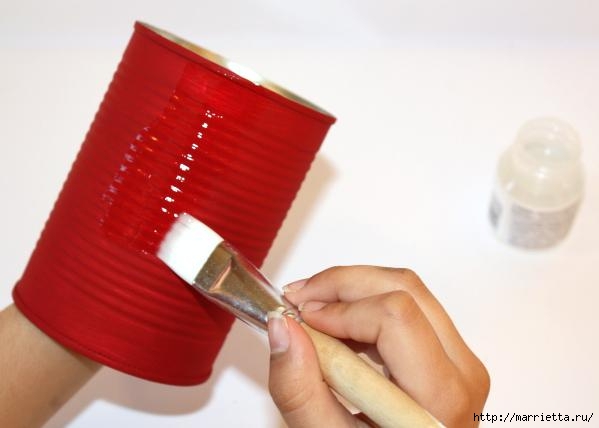
Leave the jar until the varnish dries. 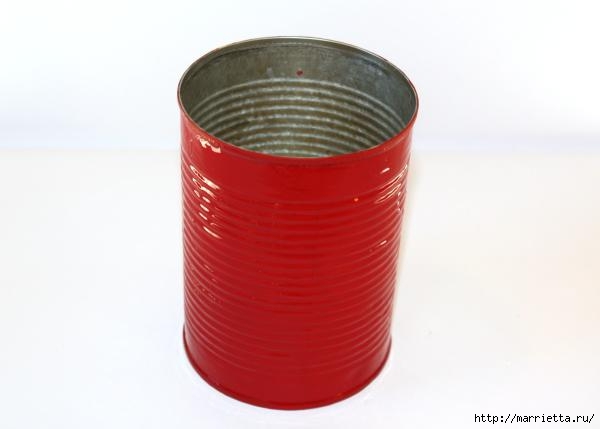
Now we take white acrylic paint and “slap it on the can”, apply it using a piece of sponge or foam rubber.
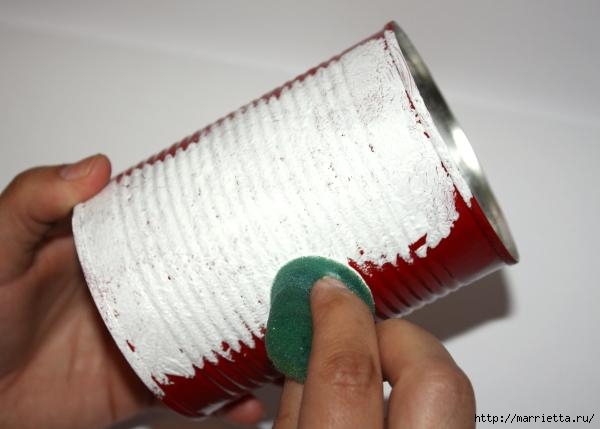
After a few minutes, we begin to observe the appearance of cracks on the can.
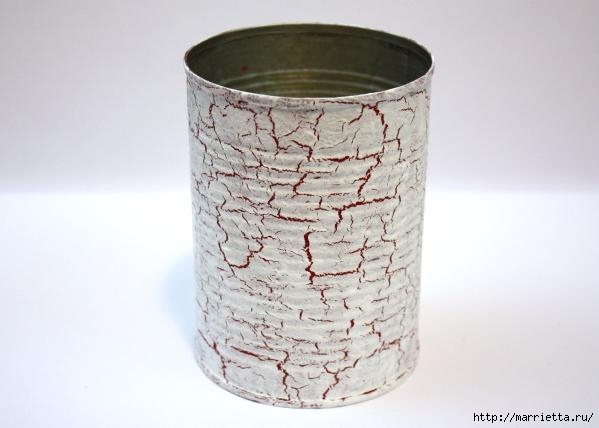
We take a napkin, separate the top layer and tear off the motif we need for decoupage.
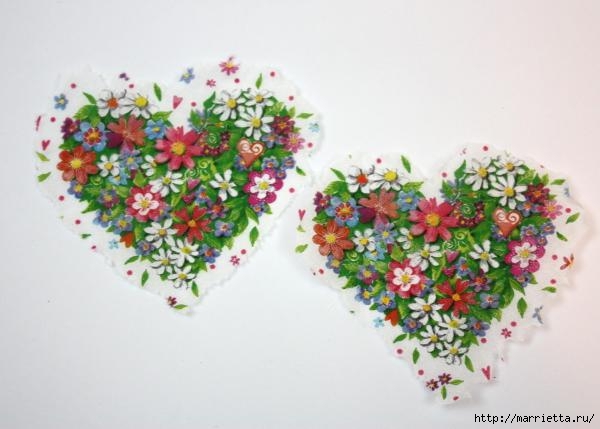
Glue the motif to the jar.

Cover the top of the motif with a layer of decoupage glue. To make it brighter, you can glue another napkin on top.
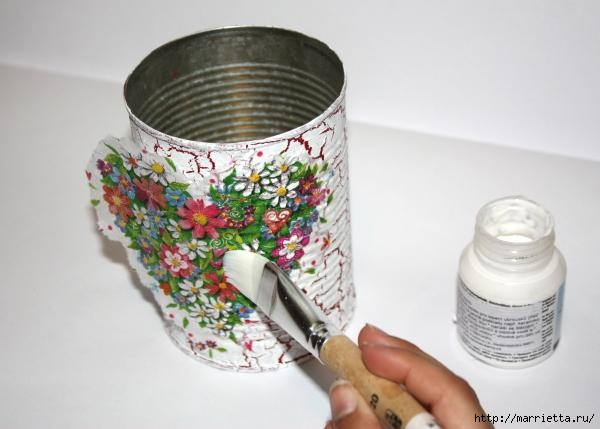

Dry the work and admire your creation)
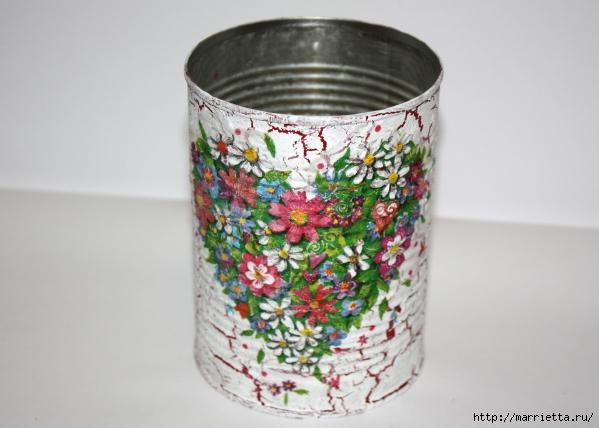
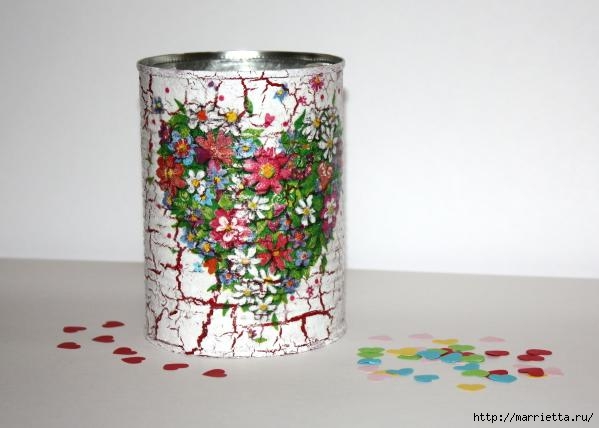
There comes a time in the life of every housewife when even the most expensive kitchen set does not bring joy and mood for cooking. Sometimes you just want some cute trinket that, with its own bright colors will warm you up and make you smile even on a bad day. The ideal solution I consider the modernization of containers for bulk seasonings to be such a problem. In that master class I will show, how to decorate jars using decoupage technique.
To make them I used:
Empty baby formula bottles;
- titanium white (as a primer),
- acrylic varnish for decoupage;
- paper napkins with a design you like;
- beads, seed beads and some regular wire.
I decided to start with the lids. To make it easier to tear off, I decided to cut the outer rim off the lid with a utility knife.

As a result of this procedure, my future lid will simply fit on top and will be easy to open and close even with one hand.

From linoleum (remnants from repairs) we cut out a circle equal to the diameter of the internal recess on the lid.
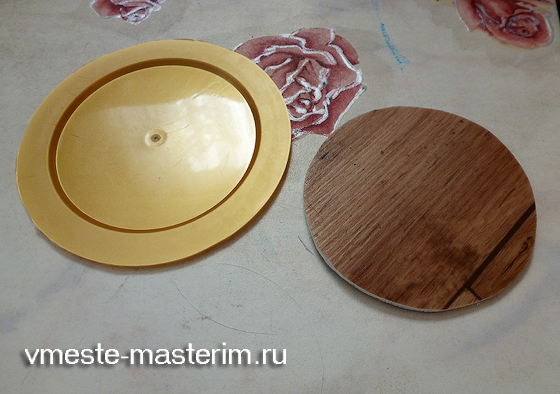
We glue a napkin onto it using varnish and decoupage techniques.
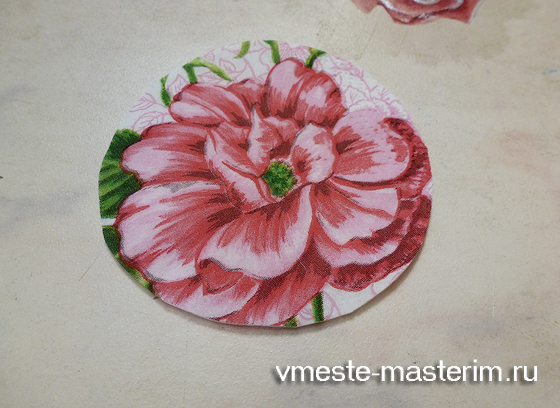
While the varnish is drying, it's time to work on the jar itself. It needs to be scratched a little with sandpaper so that there is adhesion between the metal and the next coating.
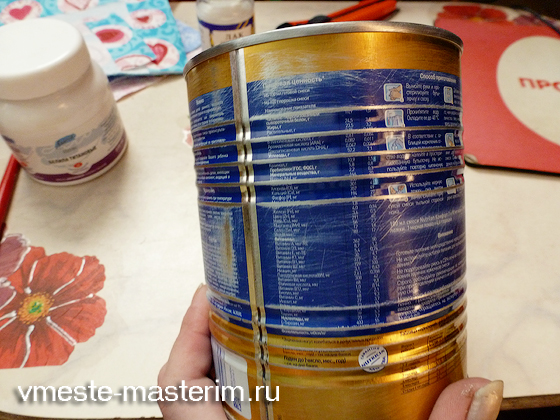
After this, cover it with several layers of white and leave it until completely dry.
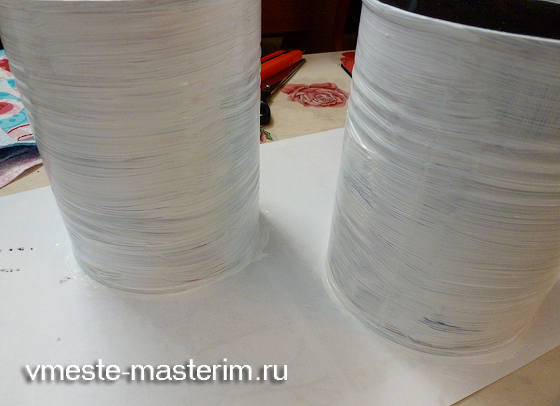
In order to have a comfortable handle on the lid, I decided to use regular large beads and seed beads.

To do this, we put a bead on the center of a piece of wire, then we thread both ends first through the middle bead, and then through the largest one. In the center of the linoleum circle, we use an awl to make a hole through which we thread both ends.


Since the edges of the lid will also be painted, they also need to be treated with a primer or whitewash.

Since I was making several jars at once, I needed to come up with some kind of distinctive feature for each, so as not to confuse them on the table in a hurry. This is the design that came to mind for a jar intended for coffee.
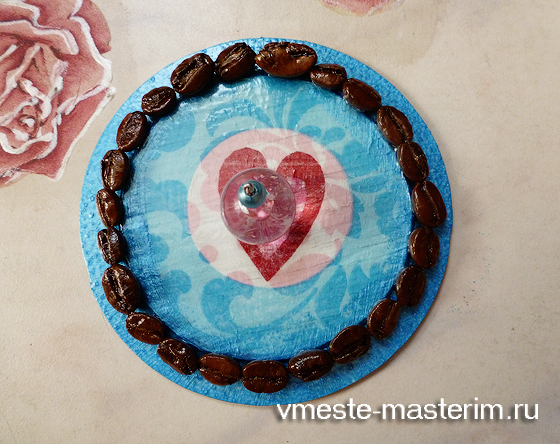
I painted the edge of the lid with regular paint. acrylic paint blue color, and glued the coffee beans with superglue. On top everything needs to be covered with several layers of decoupage varnish.
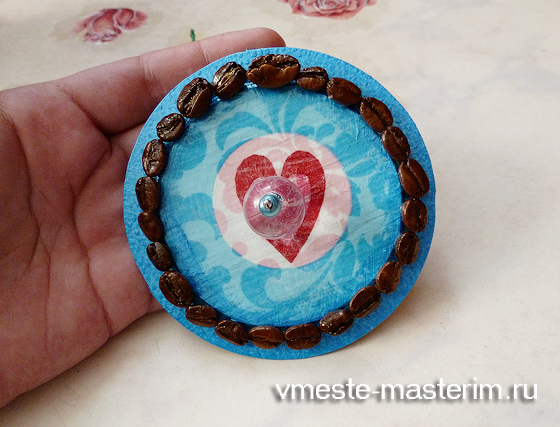
In the end, the work on the lid turns out to be almost like this flat design, which you just need to put on top of the jar.
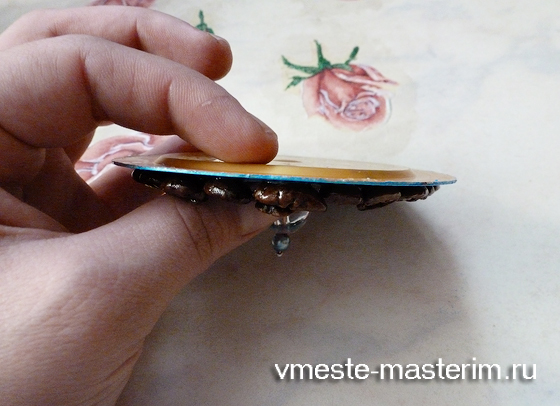
The jar itself, after the white has dried well at room temperature, you also need to cover it with a napkin using the decoupage technique. To do this, simply apply the selected part of the design and brush it with varnish on top. When wet, it sticks, and the result is this beauty.
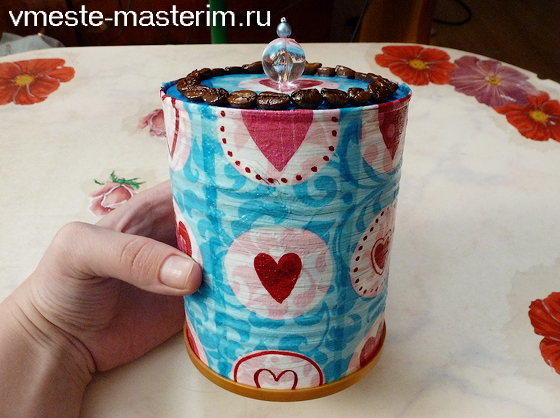
I decided to fold the napkin that remained on top inward, but it could have been torn off along the top edge.

And the rim that was cut off at first fit very well into the design of the bottom of the jar. This detail becomes indispensable kitchen table, if they also cook on it (a problem with all small kitchens). As a result of the painstaking work done, my table is now decorated with this ensemble for sugar, salt, coffee and milk powder.
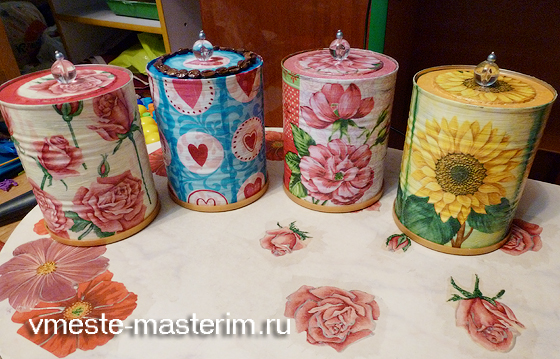
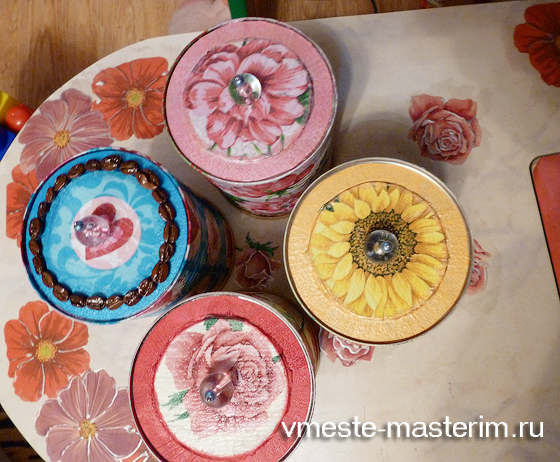
If you don’t want to train your memory by memorizing patterns, you can simply label each lid or jar with the name of the contents in a three-dimensional outline.
If you have some metal candy jar, don’t rush to throw it away, try to update it yourself using technology. I'm sure there will be a worthy use for such a cute little thing. For example, you can store bobbins in it for sewing machine or beads and beads for needlework. Or you can use it for its intended purpose - for sweets, if you want to take them with you to work, such a jar will take up very little space in your purse. Master class from.
Decoupage tin can
Materials and tools:
- metal jar,
- window cleaner,
- sandpaper No. 100, No. 400,
- latex putty,
- putty knife,
- napkin,
- primer – white rust enamel,
- brushes and foam sponges,
- office file,
- decoupage glue,
- glossy acrylic varnish,
- titanium white,
- red acrylic paint,
- cosmetic sponges (triangular shape),
- gold acrylic paint,
- yellow acrylic paint.

Operating procedure:
I found a very old metal jar, worn in places, bent in places and quite peeling. I'll try to make something decent out of it.
First, the jar needs to be rinsed and dried thoroughly, then degreased by wiping with an alcohol-containing product (I used window cleaner).
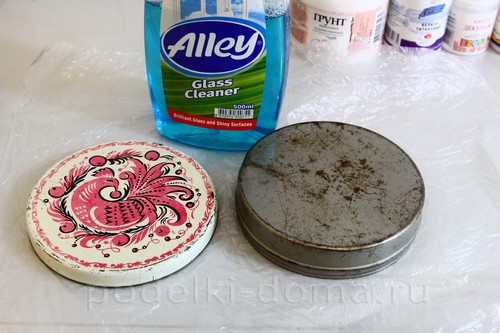
Now you need to remove all old paint using coarse sandpaper (no. 100). The bottom part of the jar, on which there was no paint, also needs to be sanded.
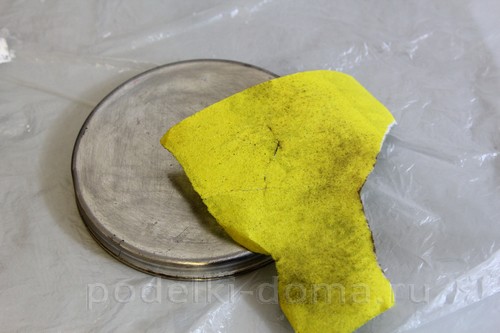
All dents need to be filled with putty, level the surface with a spatula and dry.

When the putty is completely dry, cover the jar with primer - rust enamel. I applied the first layer of enamel with a brush. Dry the first layer. Primer enamel takes much longer to dry than acrylic primer on water based It will take 6-7 hours for the jar to dry completely.
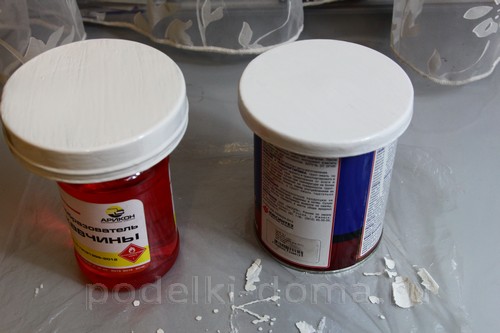
After this, treat the surface with a finer sandpaper(No. 400), it will even out small unevenness.
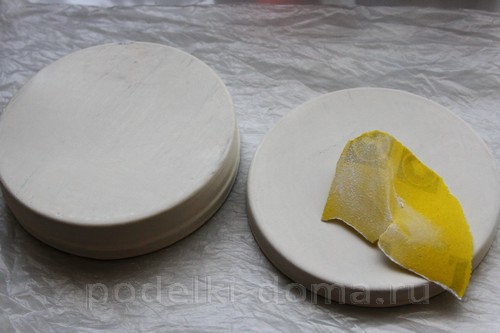
Apply the second layer of primer-enamel not with a brush, but with a piece of foam sponge. To avoid getting your hands dirty, hold the sponge not with your hands, but with a clothespin or a paper clip.
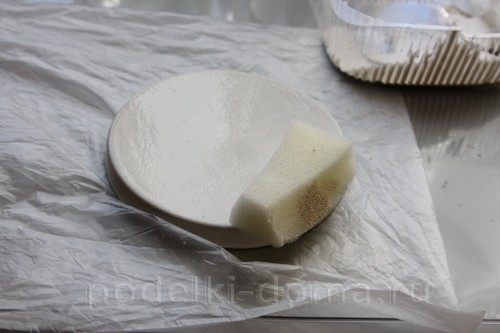
Leave the jar to dry again for 7 - 8 hours. Then polish the surface again with polishing paper. Don't forget to also paint inner surface jars.

The next stage of our work will be gluing the napkin. I chose a cupcake motif on a soft creamy, slightly pinkish background.
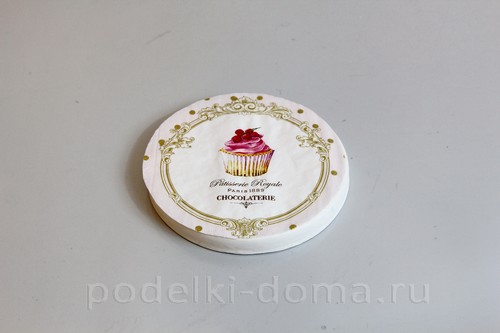
Cut the napkin to the shape of the lid. Peel off the top ink layer of the napkin. Don’t throw away the bottom two layers, they will come in handy later.
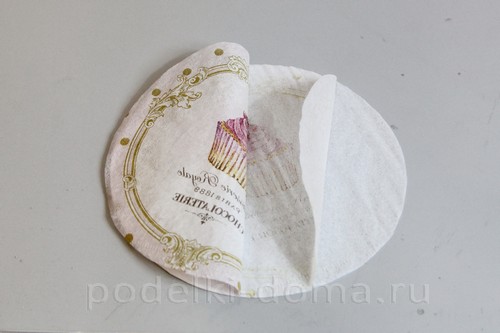
Place the napkin face down on the file and pour water over it. In the water, the napkin will wrinkle and begin to bubble; carefully touching the edges of the napkin, stretch it, trying to smooth out the folds.
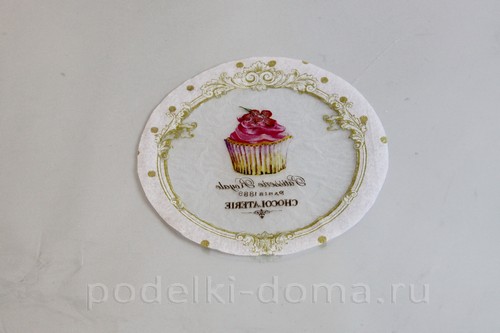
Using a brush with a beveled edge, smooth the napkin from the center to the edges, expelling air bubbles from under the napkin. When the napkin is nice and flat, fold the napkin and drain the excess water from the file.
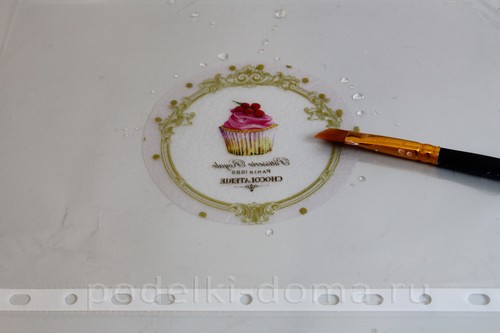
Pass the dry cloth (those two layers that you separated) over the damp cloth with blotting movements, and all remaining small air bubbles will disappear.
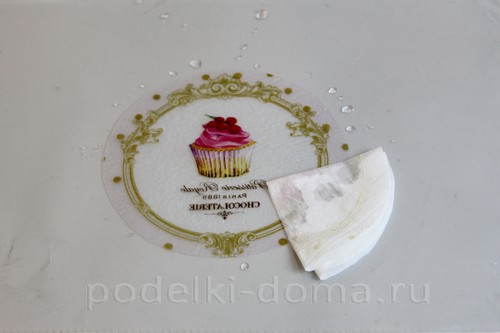
Turn the file over and place the napkin on the lid of the jar. Without removing the file, use a spatula from the center to the edges, driving out any remaining bubbles, smoothing out any remaining wrinkles and ensuring that the napkin adheres well to the jar.

Cover the napkin with glue and dry.
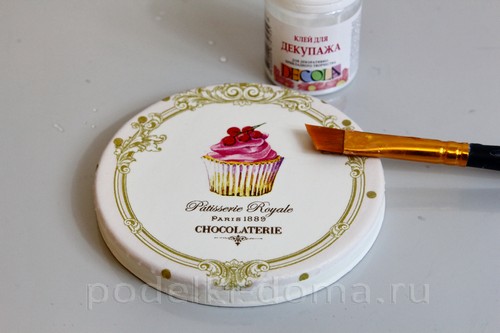
When the glue dries, polish the surface with fine sandpaper and coat it with glossy acrylic varnish.
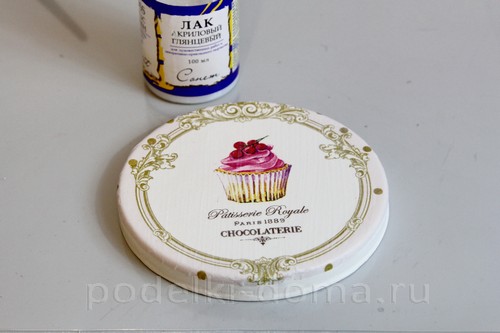
When the varnish has dried well, polish the surface again with fine sandpaper, and walk along the edge with stiffer sandpaper, tearing off the protruding edges of the napkin.

Since the background of the napkin is not white, but cream, the entire jar will have to be painted the same color. To find the right shade, I mixed titanium white with a drop of red acrylic paint.

Apply the paint with a soft cosmetic sponge, carefully working around the design. Paint the jar in as many layers as needed so that the background of the jar completely blends with the background of the design on the napkin. After each paint job (I had three coats), be sure to polish the surface with fine sandpaper.

To draw peas, mix gold paint with yellow, achieving a complete match with the paint used to paint the peas on the napkin.

Draw peas with any available tool. I used a manicure tool that makes dots on your nails.
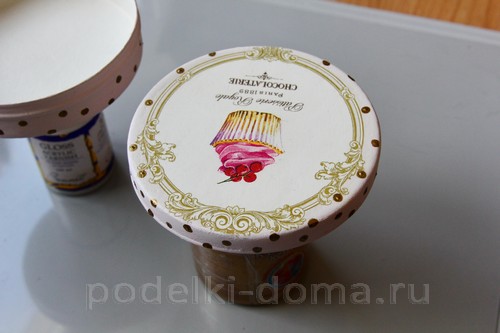
Dry the paint and coat the jar on all sides with several layers of glossy acrylic varnish, each time drying it and polishing the surface. I ended up with at least five layers of varnish. Here you go, jar updated using decoupage ready. It's impossible to recognize her!
It’s not a shame to even give such a jar as a gift!
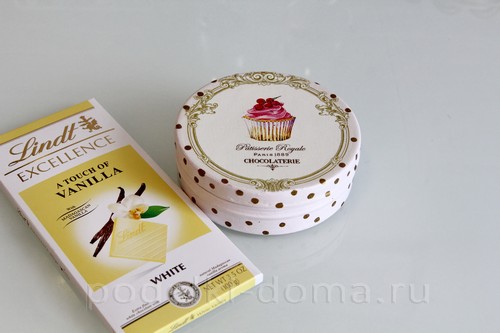
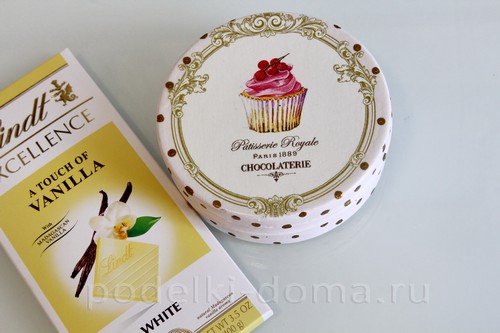

If you find an error, please select a piece of text and press the keys Ctrl+Enter. Thank you for helping to make our portal better!
How to update an old vase
A new idea for decorating a vase from Maria Lugovskaya (the author of a craft to help the photographer). "Each of the...
Box of newspaper tubes
Oksana's master class on how to make a box from newspaper tubes. "Almost every one of us...
DIY dog bed
We already have a bed for a cat, now you can sew a bed for a dog, because your faithful pets also...
Decoupage is a technique for decorating various objects and surfaces by applying a paper design and fixing it on the object using special varnishes. This technique is loved by craftswomen from all over the world; it allows you to decorate bottles and cookie jars (even metal ones) eggshell and lace, as well as other materials.
How to decoupage a tin can
Every home has many tin cans regular and baby formula or cream containers, which are often thrown away. But, if you use a little imagination and a little work, with my own hands You can make beautiful things from them that will complement the interior of your house or apartment. And if you don’t have enough imagination, you can watch a master class.
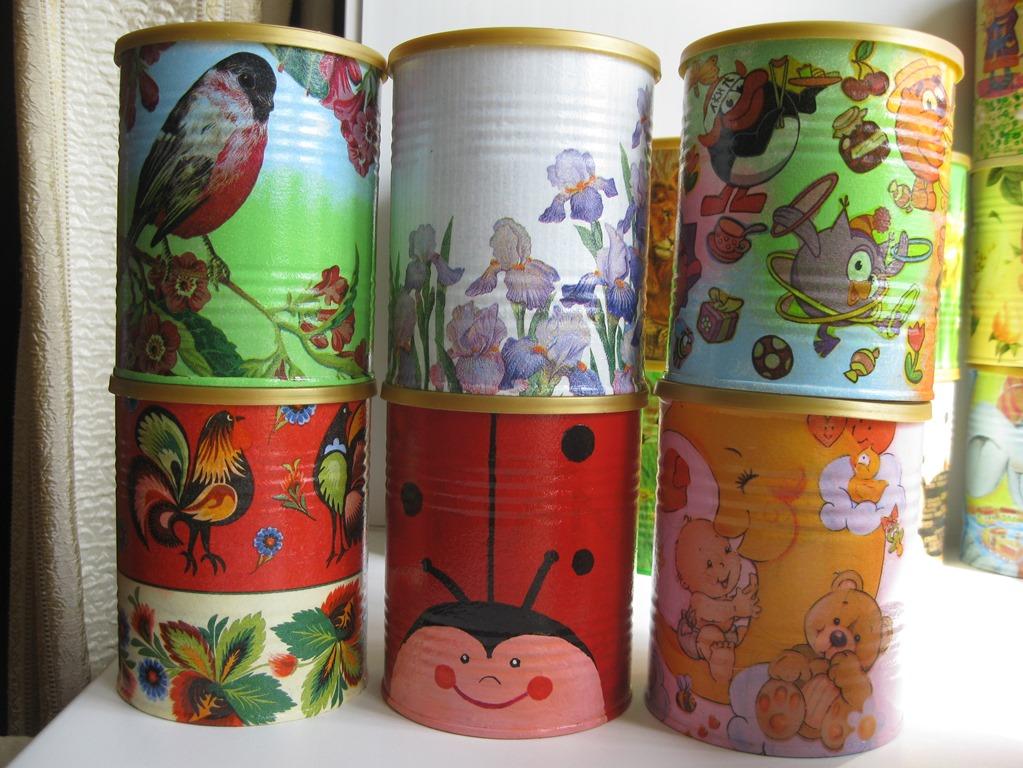
Do not forget that you need to start work by degreasing the tin surface; any alcohol-containing liquid will be suitable for these purposes.
First of all, decide what you would like to see in your product. Depending on the purpose of the item, materials are selected.
But most often you will use:
- Acrylic paints;
- Skin;
- Beautiful napkins;
For example, in order to create a beautiful flower pot, you will only need a couple of hours. To begin work, clean the surface of the jar and degrease it; now you can begin choosing a design. Here everything depends only on your imagination, you can combine various elements and textures, paint the product or decorate only some elements according to the scheme.
Various techniques for decoupage of cans and bottles
Those who have already tried to decorate several jars and bottles using the decoupage technique are unlikely to stop there. Craftswomen will want to know various techniques and create new masterpieces. Despite the apparent complexity, all decoupage techniques are quite simple. The main thing here is not to rush and then the result will exceed your wildest expectations.
For example, the reverse decoupage technique is very popular; a vase, a jar, and a bottle look impressive in it. Such jars are well suited for storing honey; it always makes such a technique stand out. Jars made in reverse decoupage style are well suited as containers for bulk products. We'll tell you how to make decor using this technique step by step.

So, let's get to work:
- In order for the image to “lay” on the surface, it must be degreased. Avoid small jars, they are very inconvenient to work with. Then, the previously selected image is glued to one of the sides of the jar, but with the picture inside.
- Keep in mind that there will be a window opposite the image, the rest of the part will be completely decorated. To make the product more interesting, the picture should also be glued to the visible sides.
- The image can be glued with any glue; after drying, varnish is carefully applied. The main thing is not to touch the glass, otherwise the whole product will not look neat.
- Next, the entire jar, except the window, is covered with paint. You can use a brush or foam rubber.
- After drying, you can begin decorating the jar itself. It depends only on the desire of the master. Some add various colors, others continue the decor using the usual decoupage technique.
- Don't forget to decorate the lid.
A piggy bank looks good in this style, but it is better to choose the largest size jar.
Works using the reverse decoupage technique are ideal for gifts.
Craftswomen love to decorate bottles using the decoupage technique. Glass is most often used, but if desired, plastic can also be used. This does not change the technique; an alcohol-containing liquid is also used to degrease the plastic surface.
Decoupage of spice jars: simple ways to decorate
Every home always accumulates a large number of glass jars different sizes. Usually they gather dust in the basement or pantry, but for the craftswoman this is simply an invaluable material for creativity. It’s especially good if the house has Small child. Then you can use the accumulated jars from under baby food. They are ideal as a container for storing spices. Using decoupage you can make them in the style of your kitchen.
It is very important to thoroughly clean the surface of the jars before starting work, otherwise you will not be able to decorate objects using the decoupage technique.
The glass surface must be cleaned of labels and any other contaminants. For these purposes, you can use water and soda, after which the jars should be washed and dried. Other surfaces can also be cleaned well with baking soda. Now you can start the work itself.
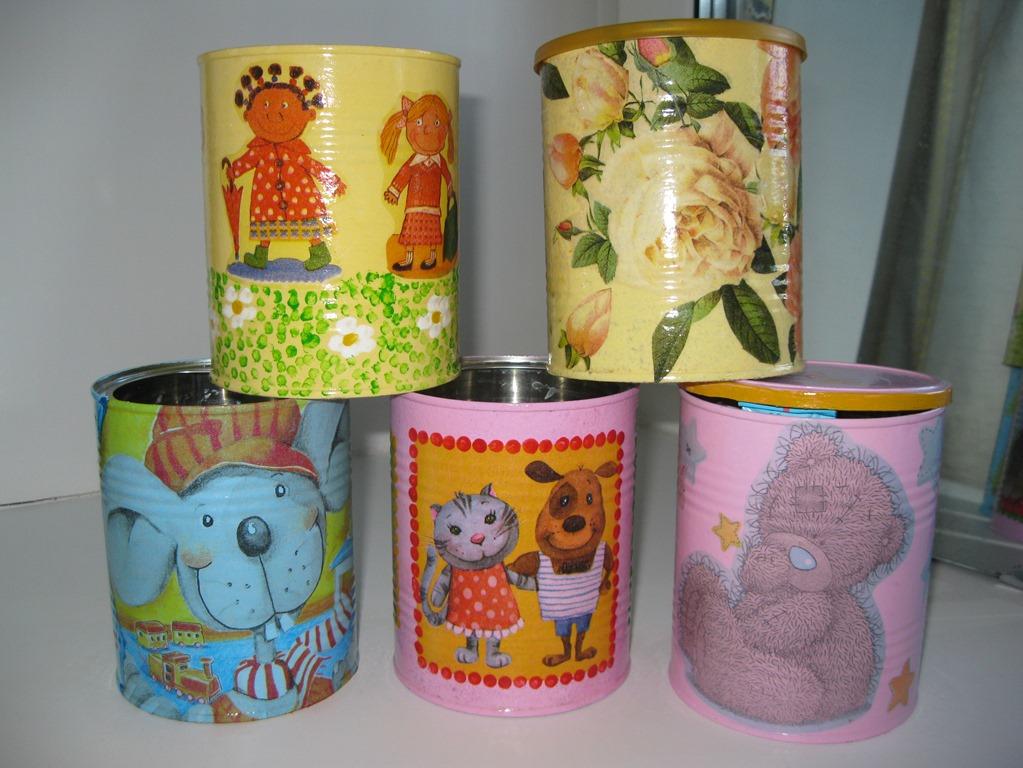
For decoration you will need:
- Glue;
- Beautiful fabric or napkins;
- Brush;
- Clean cloth;
- Acrylic paint.
The work itself will not take much time, but will require accuracy and patience. It is necessary to remove the covers and decorate them. The lids are applied to the material and a circle of slightly larger diameter is cut out. Then the napkin is generously moistened with glue; after getting wet, it is divided into several layers. Upper layer, on which the image remains, and will be applied to the cover, pre-lubricated with glue.
The image must be applied extremely carefully; bubbles are removed with a brush dipped in glue. After the pattern is fixed, it is covered with several layers of glue. If desired, the jar can be painted with acrylic paint or applied at least three layers of varnish. After drying, the lids are completely ready. To make your spice jars look more stylish, you should create vintage labels for them. They can be made from paper, fabric or wallpaper scraps.
How to cheer yourself up: decoupage of jars for the kitchen
The kitchen is a special kingdom in which there should always be good mood. But, if you suddenly urgently want to update something, then take a closer look at decorating jars in the decoupage style. It's very simple and cheap way change your kitchen and make it original.
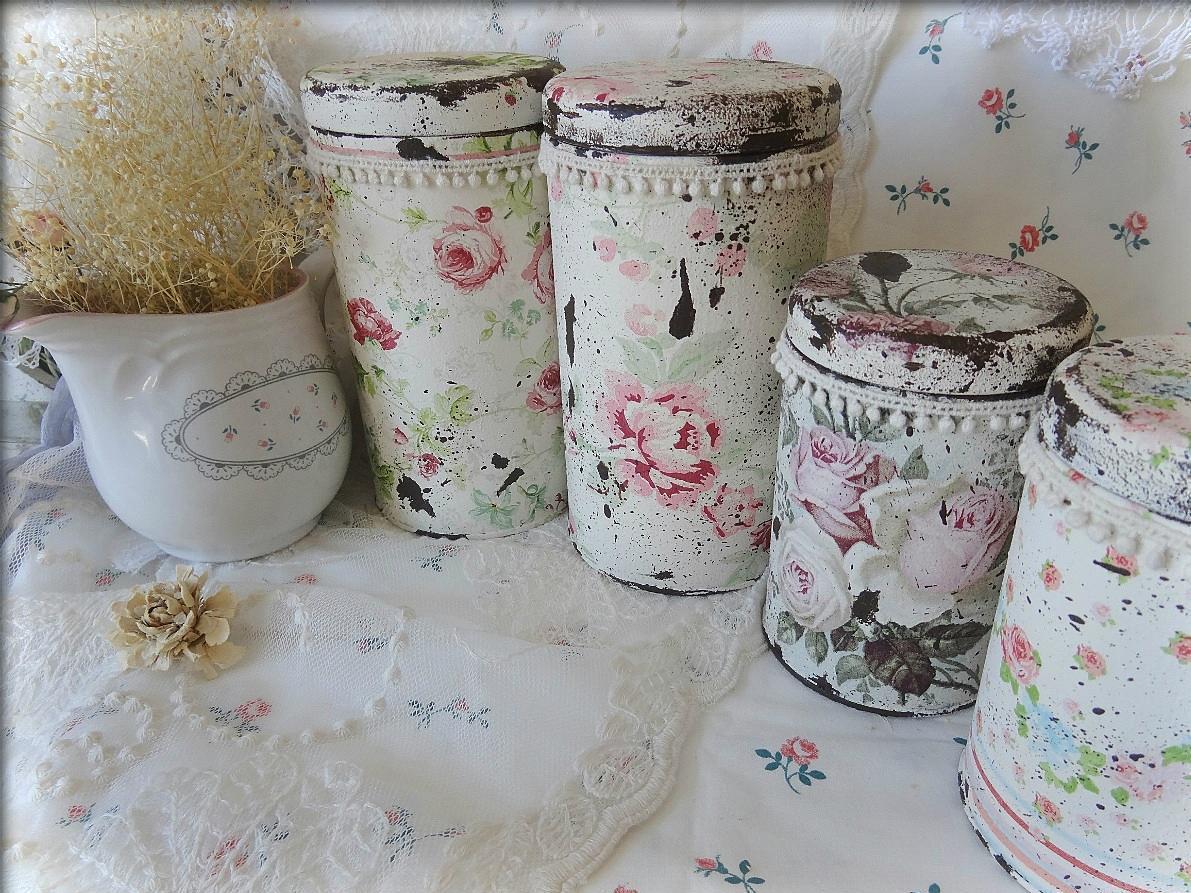
You can use it as a base various items. For example, a stand for kitchen utensils, made from a package of Pringles chips. This kind of thing always gives a special mood.
And most importantly, you don’t have to spend a lot of money on this important item in every kitchen.
Decoration is carried out using the usual decoupage technique, and ready product can be decorated with ribbons or leather cords.
Jars for bulk products in decoupage style look very interesting. They are made quickly and easily.
To work, you will need to stock up on just a few materials:
- Glue;
- Colorful napkins;
- Acrylic varnish.
This work will take you no more than two hours, and the jars will be the envy of all housewives.
Techniques for decoupage jars (video)
Using the decoupage technique you can create completely different things; the flight of creativity is practically unlimited. Modern world offers craftsmen many new materials, with which work turns into pleasure at every stage. Some stores even sell plywood blanks for decoupage, so-called coloring sheets. They allow you to create your next masterpiece as quickly as possible. In conclusion, I would like to note that for many craftswomen, a hobby has turned into a lifelong endeavor that brings serious income. Try it, maybe this is your way too.








